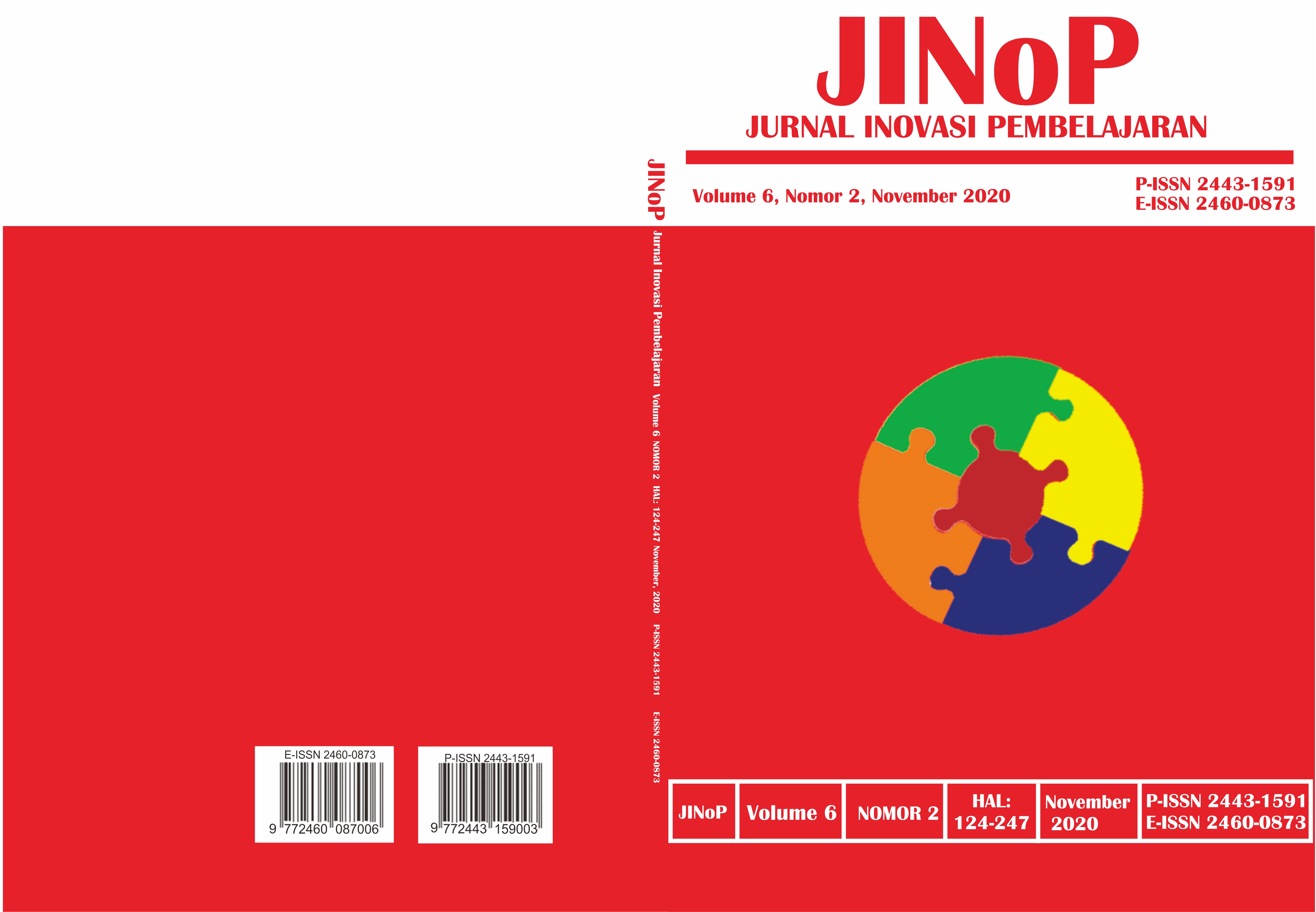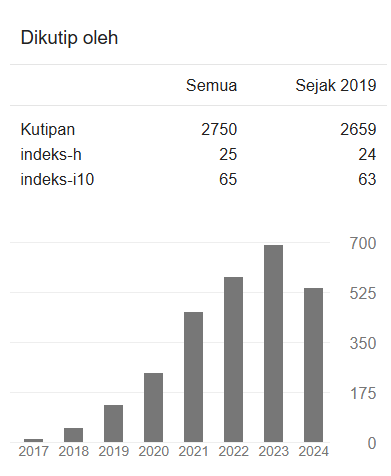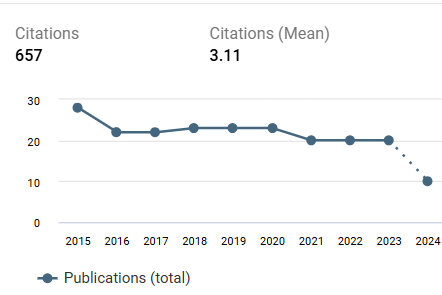The Drill Method with Realistic Approach to Improve Learning Outcomes of Descriptive Statistics in Higher Education
DOI:
https://doi.org/10.22219/jinop.v6i2.13010Keywords:
drill method, descriptive statistics learning outcomes, higher educationAbstract
Matakuliah statistik deskriptif memiliki peran penting dalam pembejaran di perguruan tinggi. Namun seringkali mahasiswa mengalami kesulitan untuk memahami konten materi statistik deskriptif. Penelitian ini bertujuan untuk mendeskripsikan peningkatan hasil belajar mahasiswa pada matakuliah statistik deskriptif dengan menggunakan metode drill. Jenis penelitian yang digunakan penelitian tindakan kelas yang dilakukan selama dua siklus. Jumlah sampel penelitian terdiri dari 35 mahasiswa semester dua yang berpartisipasi dalam pembelajaran statistik deskriptif. Pengumpulan data penelitian menggunakan instrumen yang berupa lembar observasi dan tes. Teknik analisis data yang digunakan adalah statistik deskriptif. Hasil penelitian menunjukkan bahwa penggunaan metode drill memiliki dampak terhadap peningkatan hasil belajar antara siklus I dan siklus II. Peningkatan hasil belajar mahasiswa pada siklus I diperoleh rata-rata 78,23, dan pada siklus II diperoleh rata-rata 87,14 sehingga terjadi peningkatan rata-rata hasil belajar sebesar 8,91. Berdasarkan hasil penelitian dapat disimpulkan bahwa penerapan metode drill dalam perkuliahan statistik deskriptif dapat meningkatkan hasil belajar mahasiswa pada matakuliah statistik deskriptif.
Kata kunci: metode drill, hasil belajar statistik deskriptif, pendidikan tinggi
Abstract
Descriptive statistics courses have an important role in the teaching and learning process at the higher education level. However, students often have difficulty understanding the content of descriptive statistics material. This research aimed to describe the improvement of student learning outcomes in the descriptive statistics subject by applying the drill method. The research employed classroom action research carried out in two cycles. The research consisted of 35 second-semester students as samples who participated in descriptive statistics learning. The data collection method was conducted by using instruments in the form of observation sheets and tests while the research employed descriptive statistics as a data analysis technique. The results showed that the use of the drill method had an impact on increasing learning outcomes between cycle I and cycle II. The increase in student learning outcomes in the first cycle obtained an average of 78.23, and in the second cycle, it was obtained an average of 87.14. The result was giving evidence that there was an increase in the average learning outcomes of 8.91. Based on the research results, it can be concluded that the application of the drill method in descriptive statistics lectures can improve student learning outcomes in the descriptive statistics course.
Keywords: drill method, descriptive statistics learning outcomes, higher education
Downloads
References
Ahmad, T. (2018). Paradigma Baru Pendidikan Tinggi dan Makna Kuliah Bagi Mahasiswa. Madani Jurnal Politik Dan Sosial Kemasyarakatan, 10(1), 34–52.
Alba, C. (2011). Strategi Peningkatan Mutu Pendidikan di Perguruan Tinggi. Jurnal Sosioteknologi, 10(24), 1184–1190.
Anwar, B. (2017). Konsep Pendidikan Andragogi Menurut Pendidikan Islam. Al-Daulah: Jurnal Hukum Pidana dan Ketatanegaraan, P-ISSN. https://doi.org/10.24252/ad.v6i1.4864
Blegur, J., & Lumba, A. J. F. (2019). Improving Teaching Skills of the Prospective Physical Education Teachers Through Drill Guide Method. Jurnal Pendidikan Jasmani dan Olahraga, 4(2), 178–188. https://doi.org/10.17509/jpjo.v4i2.19171
Fitri, R., & Yogica, R. (2018). Effectiveness of Concept-Based Learning Model, Drawing and Drill Methods to Improve Student’s Ability to Understand Concepts and High-Level Thinking in Animal Development Course. Journal of Physics: Conference Series, 1116(5), 52040. https://doi.org/10.1088/1742-6596/1116/5/052040
Harris, R., & Clayton, B. (2019). The Current Emphasis on Learning Outcomes. https://doi.org/10.1080/14480220.2019.1644777
Hiryanto, H. (2017). Pedagogi, Andragogi dan Heutagogi Serta Implikasinya dalam Pemberdayaan MasyarAKAT. Dinamika Pendidikan, 22(1), 65–71. Retrieved from Google Scholar
Irawan, A., & Kencanawaty, G. (2017). Implementasi Pembelajaran Matematika Realistik Berbasis Etnomatematika. Journal of Medives: Journal of Mathematics Education IKIP Veteran Semarang, 1(2), 74–81.
Irawan, G., Sugiarto, T., & Kurniawan, A. W. (2020). Upaya meningkatkan Akurasi Teknik Passing Menggunakan Metode Drill pada Kegiatan Ekstrakurikuler Sepakbola. Jurnal penjakora, 6(2), 92–101. https://doi.org/10.23887/penjakora.v6i2.19976
Kani, U. M., & Sa’ad, T. U. (2015). Drill as a Process of Education. European Journal of Business and Management, 7(21), 175–178. Retrieved from Google Scholar
Kusuma, B. J., Wardono, W., & WINARTI, E. R. (2016). Kemampuan Literasi Matematika Peserta Didik pada Pembelajaran Realistik Berbantuan Edmodo. Unnes Journal of Mathematics Education, 5(3), 199–206.
Kusumawati, E., & Irwanto, R. A. (2016). Penerapan Metode Pembelajaran Drill Untuk Meningkatkan Kemampuan Pemecahan Masalah Matematis Siswa Kelas VIII SMP. EDU-MAT, 4(1). https://doi.org/10.20527/edumat.v4i1.2289
Lim, C. S., Tang, K. N., & Kor, L. K. (2012). Drill and Practice in Learning (and Beyond) BT - Encyclopedia of the Sciences of Learning (N. M. Seel, Ed.). https://doi.org/10.1007/978-1-4419-1428-6_706
Mulati, T. S., & Rejeki, A. S. (2014). Perbedaan Pengaruh Metode Pembelajaran Simulasi dengan Latihan (drill) terhadap penerapan pengisian partograf pada Mahasiswa DIII Kebidanan. Jurnal Cakrawala Pendidikan, 33(1). https://doi.org/10.21831/cp.v1i1.1867
Ningsih, S. (2014). Realistic Mathematics Education: Model Alternatif Pembelajaran Matematika Sekolah. Jurnal Pendidikan Matematika, 1(2), 73–94.
Nulhaqim, S. A., Heryadi, D. H., Pancasilawan, R., & Ferdryansyah, M. (2016). Peranan Perguruan Tinggi dalam Meningkatkan Kualitas Pendidikan di Indonesia untuk Menghadapi ASEAN Community 2015 Studi Kasus: Universitas Indonesia, Universitas Padjadjaran, Institut Teknologi Bandung. Share: Social Work Journal, 6(2), 197.
Pane, A., & Dasopang, M. D. (2017). Belajar dan Pembelajaran. Fitrah: Jurnal Kajian Ilmu-Ilmu Keislaman, 3(2), 333–352. https://doi.org/10.24952/fitrah.v3i2.945
Rahmah, A., & Hasibuan, A. F. (2019). Penerapan Model Circuit Learning dengan Metode Pembelajaran Drill untuk Meningkatkan Kemandirian dan Hasil Belajar Akuntansi. Jurnal Akuntansi Dan Pembelajaran, 8(2).
Rathakrishnan, M., Raman, A., & Haniffa, M. (2018). The Drill and Practice Application in Teaching Science for Lower Secondary Students. 3. Retrieved from Google Scholar
Ratnaningsih, E. (2012). Efektivitas Metode Drill dan Resitasi Dalam Meningkatkan Pemahaman dan Ketrampilan Siswa Terhadap Hukum Bacaan Qolqolah dan Ro’Di SMP Negeri 1 Subang. Jurnal Pendidikan Agama Islam-Ta’lim, 10(1), 79–94.
Rivan, Y. M., Rahmi, F., & Masnarivan, Y. (2018). Pengaruh Metode Drill Terhadap Peningkatan Kemampuan Mahasiswa pada Mata Kuliah Statistik. Jurnal Kepemimpinan dan Pengurusan Sekolah, 3(2), 145–150. https://doi.org/10.34125/kp.v3i2.300
Setiowati, N. E. (2016). Perpaduan Konsep Metode Pembelajaran Somatis Auditory Visual Intelektual (SAVI) dengan Metode Drill dalam Peningkatan Kualitas Pembelajaran Akuntansi. Edueksos: Jurnal Pendidikan Sosial & Ekonomi, 2(2). https://doi.org/10.24235/edueksos.v2i2.643
Sihaloho, L. (2018). Pengaruh Efikasi Diri (Self Efficacy) terhadap Hasil Belajar Ekonomi Siswa Kelas XI IPS SMA Negeri Se-Kota Bandung. JINoP (Jurnal Inovasi Pembelajaran), 4(1), 62–70.
Smaldino, S. E., Lowther, D. L., Russell, J. D., & Mims, C. (2008). Instructional technology and media for learning (Twelfth). Pearson Merrill Prentice Hall Upper Saddle River, NJ.
Suhendro, P. (2014). Penerapan It/Ict Dalam Pendidikan Andragogi Berbasis Kearifan Lokal Yang Terintegrasi Dalam Pembelajaran Sebagai Upaya Pembentukan Karakter Mahasiswa. Jurnal Tarbiyah, 21(1).
Sutiah, S. (2016). Peningkatan Hasil Belajar Siswa Melalui Metode Drill Materi Operasi Hitung Bilangan Bulat dan Pemecahan Masalah pada Mata Pelajaran Matematika di Kelas V SDN 165726 Tebing Tinggi. Elementary School Journal PGSD FIP UNIMED, 5(1), 155–164. https://doi.org/10.24114/esjpgsd.v5i1.4154
Wahyuni, N. (2016). Penggunaan Metode Drill Dalam Pembelajaran Matematika. Prosiding, 2(1). Retrieved from http://journal.uncp.ac.id/index.php/proceding/article/view/576
Wahyuni, N., Rahman, A., & Ilyas, M. (2017). The Effect Of Implementing Drill Method Towards Learnin3g Result and Motivation Based on Initial Mathematics Ability. International Conference on Natural and Social Science (ICONSS).
Wibowo, A. (2017). Pengaruh Pendekatan Pembelajaran Matematika Realistik dan Saintifik Terhadap Prestasi Belajar, Kemampuan Penalaran Matematis dan Minat Belajar. Jurnal Riset Pendidikan Matematika, 4(1), 1–10.
Yusri, Y. (2017). Strategi Pembelajaran Andragogi. Al-Fikra, 12(1), 25–52. https://doi.org/10.24014/af.v12i1.3861
Downloads
Published
How to Cite
Issue
Section
License
Copyright (c) 2020 Novi Ayu Kristiana Dewi, Trisnawati Trisnawati, Marilin Kristina

This work is licensed under a Creative Commons Attribution 4.0 International License.
Copyright Notice
Authors who publish with JINoP (Jurnal Inoasi Pembelajaran) agree to the following terms:
- For all articles published in the JINoP (Jurnal Inovasi Pembelajaran), copyright is retained by the authors. Authors give permission to the publisher to announce the work with conditions. When the manuscript is accepted for publication, the authors agree to the automatic transfer of the publishing right to the publisher.
- Authors retain copyright and grant the journal the right of first publication with the work simultaneously licensed under a Creative Commons Attribution 4.0 International License. that allows others to share the work with an acknowledgment of the work's authorship and initial publication in this journal.
- Authors are able to enter into separate, additional contractual arrangements for the non-exclusive distribution of the journal's published version of the work (e.g., post it to an institutional repository or publish it in a book), with an acknowledgment of its initial publication in this journal.
- Authors are permitted and encouraged to post their work online (e.g., in institutional repositories or on their website) prior to and during the submission process, as it can lead to productive exchanges, as well as earlier and greater citation of published work (See The Effect of Open Access).








